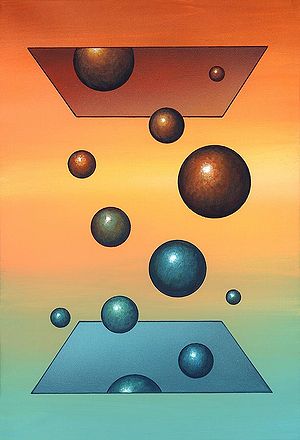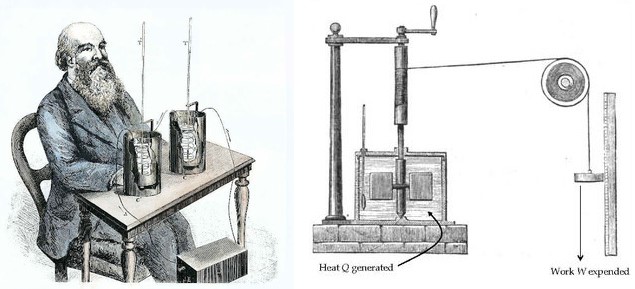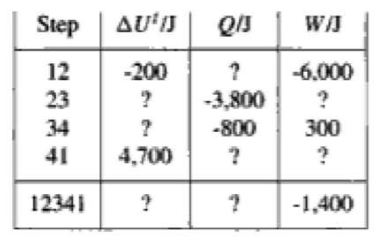First Law of Thermodynamics: Difference between revisions
No edit summary |
No edit summary |
||
| Line 110: | Line 110: | ||
<math>Q(34) = -800J, W(34) = 300J</math> | <math>Q(34) = -800J, W(34) = 300J</math> | ||
<math>∆U_t(34)= Q(34) + W(34) = -800J + 300J = -500J<math> | <math>∆U_t(34)= Q(34) + W(34) = -800J + 300J = -500J</math> | ||
<math>∆U_t</math> is a state function. That means a <math>∆U_t</math> for series of steps that leads back to the initial state must be zero. | <math>∆U_t</math> is a state function. | ||
That means a <math>∆U_t</math> for series of steps that leads back to the initial state must be zero. | |||
The sum of U for all of the steps must be zero. | The sum of U for all of the steps must be zero. | ||
| Line 123: | Line 124: | ||
Step 2 to 3: | Step 2 to 3: | ||
<math>∆U_t(23) = -4000J, Q(23) = -3800J</math> | <math>∆U_t(23) = -4000J, Q(23) = -3800J</math> | ||
<math>W(23) = ∆U_t(23) - Q(23) = -4000J - (-3800J) = -200J</math> | <math>W(23) = ∆U_t(23) - Q(23) = -4000J - (-3800J) = -200J</math> | ||
<math>W(12341) = -1400J</math> | <math>W(12341) = -1400J</math> | ||
<math>W(41) = W(12341) - W(12) - W(23) - W(34) = -1400J - (-6000J) - (-200J) - 300J = 4500J</math> | <math>W(41) = W(12341) - W(12) - W(23) - W(34) = -1400J - (-6000J) - (-200J) - 300J = 4500J</math> | ||
Step 4 to 1: | Step 4 to 1: | ||
<math>∆U_t(41) = 4700J W(41) = 4500J</math> | <math>∆U_t(41) = 4700J W(41) = 4500J</math> | ||
<math>Q(41) = ∆U_t(41) - W(41) = 4700J - 4500J = 200J</math> | <math>Q(41) = ∆U_t(41) - W(41) = 4700J - 4500J = 200J</math> | ||
Revision as of 20:12, 27 November 2016

Claimed by Mlee406 for fall 2016
The science of thermodynamics originated in the 19th century in order to explain the mechanism of steam engines. The term 'thermodynamics' means power developed from heat, and thermodynamics deals with the relationship between heat and other forms of energy. One can apply thermodynamics to a problem, beginning with identifying a body of matter called system. A system's thermodynamics state is defined by several macroscopic properties that depend on the fundamental dimensions such as time, temperature, mass, length, and etc.
Background
Joule's Experiment: Mechanical Equivalent of Heat
James P. Joule's experiments made major contributions to the formation of the modern concept of heat. Joule put certain amounts of mercury, water, and oil into an insulated container and mixed the liquid using a rotating stirrer. He carefully measured how much work was done by the stirrer to the liquid and the change in temperature that the liquid experienced. Joule discovered that for a particular fluid, a fixed amount of work is required per unit mass in order to raise its temperature by one degree. Joule established that heat is a form of energy and that there is a quantitative relationship between heat and work.
Internal Energy
In Joule's experiment, work added to the liquid was transformed into heat. The energy in between the transition is contained in the liquid in a different form, called internal energy. It is named 'internal' in order to distinguish it from kinetic and potential energy, which can be considered 'external', as they depend on the substance's position or motion. Internal energy cannot be measured directly and its absolute values are unknown. However, this is no problem as we are only concerned with changes in internal energy in thermodynamics.
The Main Idea
It is crucial to recognize heat and internal energy as forms of energy through the previous section to understand the first law of thermodynamics. We can now extend scope of the law of conservation of mechanical energy from work and external potential and kinetic energy to heat and internal energy. First Law of Thermodynamics states, although energy comes in various forms, the total quantity of energy stays the same and the energy disappearing in one form must appear simultaneously in other forms.
A Mathematical Model
In the thermodynamics analysis, system is the region in which the process takes place in and the surroundings are everything that the system interacts with. First law is applied to the system and its surroundings, [math]\displaystyle{ ∆ }[/math](Energy of the system) + [math]\displaystyle{ ∆ }[/math](Energy of surroundings) [math]\displaystyle{ = 0 }[/math]
In a closed system, no streams enter nor leave the system and there is no transfer of matter across the boundary of system and its surroundings. All exchange in energy occur as heat and work and total energy change is the net energy transported as heat or work.
[math]\displaystyle{ ∆U = Q+W }[/math] where [math]\displaystyle{ ∆U }[/math] is change in the internal energy , [math]\displaystyle{ Q }[/math] is heat added to the system, and [math]\displaystyle{ W }[/math] is the work done by or done on the system. In other words, change in internal energy is equal to flow of heat into a system plus the work done by or on the system. [math]\displaystyle{ Q }[/math] and [math]\displaystyle{ W }[/math] are energy in transit; they are never stored nor contained in the body. Whereas, potential, kinetic, and internal energy are stored with the matter. While both [math]\displaystyle{ Q }[/math] and [math]\displaystyle{ W }[/math] are path functions, [math]\displaystyle{ ∆U }[/math] is a path-independent state function, which means that it only depends on the current state of the system.
First Law of Thermodynamics may also be written as:
[math]\displaystyle{ E^t }[/math] = Total Energy, [math]\displaystyle{ KE }[/math] = Kinetic Energy, [math]\displaystyle{ PE }[/math]=Potential Energy
[math]\displaystyle{ ∆E^t = ∆KE + ∆PE + ∆U }[/math]
[math]\displaystyle{ ∆E^t = Q + W }[/math]
[math]\displaystyle{ ∆KE + ∆PE + ∆U = Q + W }[/math]
A Computational Model
http://jersey.uoregon.edu/vlab/Thermodynamics/
This virtual experiment gives you visual representation of thermal equilibrium and how it is reached when beginning with different initial conditions.
Examples
Simple
Heat of 5000J is added to a closed system and the internal energy is decreased by 11000J. How much energy is transferred as work?
Solution:
[math]\displaystyle{ ∆U = Q + W }[/math], [math]\displaystyle{ Q= 5000J }[/math], [math]\displaystyle{ ∆U=-11000 J }[/math]
[math]\displaystyle{ -11000J = 5000J + W }[/math]
[math]\displaystyle{ W = -11000J-5000J }[/math]
[math]\displaystyle{ W = -16000J }[/math]
Middling
An egg, initially at rest, is dropped onto a concrete surface and breaks. Treat the egg as the system.
a) What is the sign of [math]\displaystyle{ W }[/math]?
b) What is the sign of [math]\displaystyle{ ∆PE }[/math]?
c) What is [math]\displaystyle{ ∆KE }[/math]?
d) What is [math]\displaystyle{ ∆U }[/math]?
e) What is the sign of [math]\displaystyle{ Q }[/math]?
Solution:
Utilizing [math]\displaystyle{ ∆KE+∆PE+∆U=Q+W }[/math]
a) No work is done on the system + no work is done by the system to the surroundings, thus [math]\displaystyle{ W }[/math] = 0.
b) Egg is falling from a higher surface, which means the elevation is decreased and the sign of [math]\displaystyle{ ∆PE }[/math] is negative (-).
c) Because the egg is at rest for both the initial and final state, [math]\displaystyle{ ∆KE }[/math] = 0.
d) The chemical state of egg does not change (it does not get scrambled), thus [math]\displaystyle{ ∆U }[/math] = 0.
e) From the above equation, the values with zero ([math]\displaystyle{ W }[/math], [math]\displaystyle{ ∆PE }[/math], and [math]\displaystyle{ ∆KE }[/math]) can all be cancelled and [math]\displaystyle{ ∆PE }[/math] would equal [math]\displaystyle{ Q }[/math].
[math]\displaystyle{ ∆PE = Q }[/math]
Because the [math]\displaystyle{ ∆PE }[/math] is negative(-), [math]\displaystyle{ Q }[/math] is also negative.
Difficult
One mole of gas in a closed system undergoes a four-step thermodynamic cycle. Using the below data, determine numerical values for the missing quantities.
Solution:
[math]\displaystyle{ ∆U_t = Q+W }[/math]
step 1 to 2: [math]\displaystyle{ ∆U_t(12) = -200J, W(12) = -6000J }[/math]
[math]\displaystyle{ Q(12)=∆U_t(12) - W(12) = -200J - (-6000J) = 5800J }[/math]
step 3 to 4: [math]\displaystyle{ Q(34) = -800J, W(34) = 300J }[/math]
[math]\displaystyle{ ∆U_t(34)= Q(34) + W(34) = -800J + 300J = -500J }[/math]
[math]\displaystyle{ ∆U_t }[/math] is a state function. That means a [math]\displaystyle{ ∆U_t }[/math] for series of steps that leads back to the initial state must be zero. The sum of U for all of the steps must be zero.
[math]\displaystyle{ ∆U_t(12341) = 0 }[/math]
[math]\displaystyle{ ∆U_t(41) = 4700J }[/math]
∆U_t(23) = 0 - ∆U_t(12) - ∆U_t(34) - ∆U_t(41) = 0 - (-200J) - (-500J) - 4700J = -4000J</math>
Step 2 to 3: [math]\displaystyle{ ∆U_t(23) = -4000J, Q(23) = -3800J }[/math]
[math]\displaystyle{ W(23) = ∆U_t(23) - Q(23) = -4000J - (-3800J) = -200J }[/math]
[math]\displaystyle{ W(12341) = -1400J }[/math]
[math]\displaystyle{ W(41) = W(12341) - W(12) - W(23) - W(34) = -1400J - (-6000J) - (-200J) - 300J = 4500J }[/math]
Step 4 to 1: [math]\displaystyle{ ∆U_t(41) = 4700J W(41) = 4500J }[/math]
[math]\displaystyle{ Q(41) = ∆U_t(41) - W(41) = 4700J - 4500J = 200J }[/math]
Connectedness
1. How is this topic connected to something that you are interested in?
- Thermodynamics is seen in all aspects of life, in everything from melting ice cubes to flipping switches to cooking.
2. How is it connected to your major?
- Thermodynamics is useful to know, and is covered in the Fundamentals of Engineering exam. Engineers interested in passing the FE and other similar tests should have a strong foundation in thermodynamics.
3. Is there an interesting industrial application?
- Thermodynamics is relevant in the energy,transportation, and HVAC industries.
See also
Further reading
- Thermodynamics (Dover Book on Physics) by Enrico Fermi
- Engineering Thermodynamics by P. K. Nag
- M. J. Moran and H. N. Shapiro, ‘Fundamentals of Engineering Thermodynamics’, Fourth Edition, Wiley, New York, 2000
- Thermodynamics: An Engineering Approach by Cengel, Ya and Boles, M.A.
External links
- http://www.scientificamerican.com/article/bring-science-home-reaction-time/
- http://www.physlink.com/Education/AskExperts/ae280.cfm
- http://web.mit.edu/16.unified/www/FALL/thermodynamics/notes/node15.html
- http://hyperphysics.phy-astr.gsu.edu/hbase/thermo/firlaw.html
- ThermoNet
- Khan Academy: First Law of Thermodynamics
References
- Callen, Herbert B. (1985). Thermodynamics and an Introduction to Thermostatistics. Wiley. p. 5,37.
- http://fineartamerica.com/featured/1-thermodynamics-conceptual-artwork-richard-bizley.html
- http://www.humanthermodynamics.com/Clausius.html
- http://web.mit.edu/16.unified/www/FALL/thermodynamics/notes/node15.html

